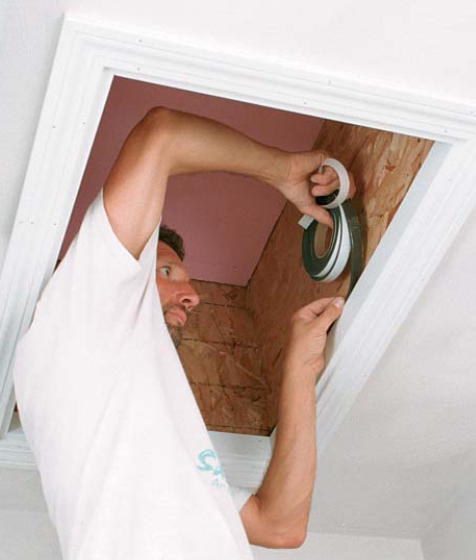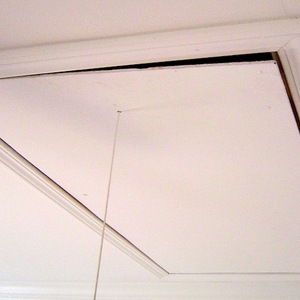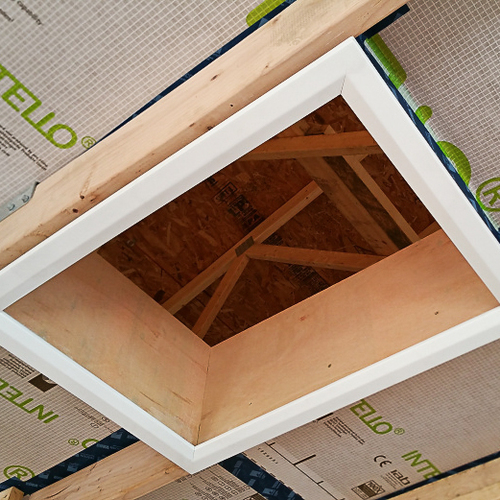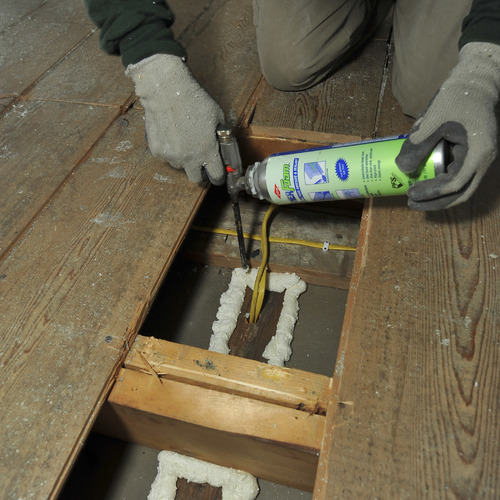Image Credit: Fine Homebuilding
Image Credit: Fine Homebuilding As this thermal image shows, poorly detailed attic access hatches leak a lot of heat. To fix this energy nosebleed, the hatch needs thicker insulation, good weatherstripping, and tight latches. Some builders make their attic access hatches out of SIP scraps.
Image Credit: Fine Homebuilding
There’s a subset of issues in the realm of home efficiency that falls into the category “out of sight/out of mind.” The boiler in the basement, how much insulation is in the attic … as long as these issues stay out of your view, no problem. So what’s up with attic hatches, then?
Even though attic hatches can be huge air leaks and sources of radiant heat loss, they are rarely fixed. An attic hatch is usually located in a hallway or closet where the homeowners see it daily. Yet…
I mean, once the homeowners fire up a blower door and whip out their infrared camera, the problems with attic hatches are pretty obvious. Wait — what … ?
That is the stealth problem with attic hatches; they appear fine but are actually a huge heat loss. An attic hatch can have finished trim and paint, look perfect, and still be a giant heat sink. In the summers, it will radiate heat down into the house and in the winter, heat and warm air will escape. So what to do?
The goal is two-fold: air-sealing to prevent air-transported heat loss and beefing up the insulation. No puny single fiberglass batts for us. For the purpose of this, we’re assuming an uninsulated 2′ x 2′ plywood hatch with finish molding over the rough-cut hole.
Air-seal the trim – The first step is air-sealing the finish trim and enclosure around the attic hatch. Carefully pull down the finish trim. (Pray that the installer used finish nails and not, say, ring-shank nails.) Set aside the trim and, using caulk for smaller gaps (less than 1/4″) or foam sealant for larger ones, seal the gap between the attic hatch framing and the rough cut drywall. (I have to be just a shade vague there, as the drywall can either butt up against the hatch frame or lap over it).
Apply a bead of caulk on the inside and outside edges of the trim, and then reattach it.
Air-seal the hatch perimeter – The plywood hatch rests on a small wood strip lip. The standard air-sealing recommendation is to install a compression bulb weatherstrip. This can also be beefed up to a sealing gasket like the one on your refrigerator door. Gaskets are generally more durable and produce a tighter seal.
Insulate the hatch – Cut foam board to 1/2″ less than the size of the hatch on each side. Foil-faced polyiso is the greenest and best-performing of the rigid foam options. Apply a bead of foam-compatible glue to it and attach it to the plywood hatch. Wash, rinse and repeat until you have added at least 4 inches of foam (but preferably 8 inches + of foam).
Fasteners – Add a handle and several hook-and-eye fasteners situated so that when the hatch is forcefully pulled down, it tightly compresses the gasket.
Attic hatches are the “Purloined Letter” of house efficiency problems. They’re in plain sight but rarely addressed adequately. Insulate and air-seal your attic hatch to save money and improve your house’s comfort.
_________________________________________________________________________
Erik North, the owner of Free Energy Maine, is an energy auditor and home performance specialist in Westbrook, Maine. He is also the author of the Energy Auditing Blog.
Weekly Newsletter
Get building science and energy efficiency advice, plus special offers, in your inbox.
















19 Comments
Nice Blog
Erik,
I think you should add that the air-tightness of the hatch can also be a significant issue in Summertime.
If the Home is air conditioned ...
the Cold Dense Air will spill/leak out at the bottom of the house ...
reduce the pressure in the top of the house...
and then allow Hot and sometimes moist attic air to spill/leak into the house thru the gaps in the hatch
Also... I think the best attic hatch is "No attic Hatch" as practiced by Robert Riversong and Lucas Durand .... They incorporated a "hay-loft-like" attic door in the gable wall instead
another approach
I solved the dilemma of how to seal my drop-down attic stairs by not sealing it at all, I put it on the screen porch instead of inside the house.
another approach
Robert, I like your suggestion
Thank you!
Bookmarked...
By the way...
If someone can provide a link to a picture of the Riversong hay-loft access door, I would appreciate seeing it.
Response to Gordon Taylor
Gordon,
Here you go:
OK...
Doesn't get much simpler than that! Just like in Iowa. Thanks.
Down here in Florida
We fix attic hatch leaks by sprayfoaming the attic above.
We don't worry much about air and heat / cool leaks through attic hatches and scuttle holes since their contribution to energy waste is far eclipsed by the typical homes reliance upon several hundred linear and square feet of ductwork in the attic.
A typical home with attic ductwork loses 1/4 - 1/3 of its total heating / cooling system capacity to the fact that the vast majority of the duct system is in the unconditioned attic.
Attic heat soaks into the ductwork, and losses of supply air through duct leaks leave the home via the attic.Return air temperatures are elevated in summer and depressed in winter by air leaks into return ductwork from vented attics.
With several hundred SF of moderately to poorly insulated as well as air-leaking ductwork in a typical attic, an attic hatch consisting of poorly insulated and poorly sealed 8 square feet and 12 linear feet is a relatively minor concern.
Being a Mainer...
John,
Being a Mainer (and previously Mass and Minnesota), sometimes I get a bit too winter-centric. But you're absolutely right. The temp differences an attic hatch copes with during the summer is just as severe as the winter.
In new construction, no attic hatch is the way to go. To paraphrase my business motto, the best attic hatch is the one you don't have to air seal and insulate.
Down in FL
Curt,
Thanks for the comment. That makes sense...you condition the attic space and move the ducting and hatch within the building envelope.
In Maine (and most of New England), we store giant stone humidifiers under our houses (the basement). Combine that with some stack effect and a housing stock that predates modern air sealing by a century or two and every scrap of sealing up the attic deck is hugely magnified in importance.
Attic hatch loss
I know that hatches are rarely well insulated and leak like a screen door. Whenever I hear an expert comment on how serious the energy loss is , what comes to my mind is "just how much energy is lost through a bad attic hatch?" What is the cost of this "bad" two square feet. I know I can spend half a day rebuilding a hatch, insulating it and weatherstripping it. If it is a pull down stairs, oh my!!! I can't tell the customer the cost of dealing with the damn hatch and just roll it into the cost of insulating and air sealing the attic. what is the payoff??
Attic hatch heat loss
Steven,
I don't think anyone is claiming it's a major source of heat loss. Between solid surface and air leakage, we might be talking 15-20 therms if the judges are feeling generous. Laughably small compared to most major heat loss sources.
Would it make sense for a contractor to spend half a day on (if that was the only project)? No, probably not unless it's rolled into a larger project. If a homeowner wanted to spend a few hours and $40 on polyiso, weatherstripping and caulk? Yes, it makes sense.
But that assumes heat loss is the only thing. We're also talking the integrity of the attic air barrier. Check out the photo at the bottom of this post:
http://www.energyauditingblog.com/what-is-humidity/
It's from the roof deck of an addition off an 1850s Maine farmhouse. There was massive crawlspace moisture, streaming up through the house. Mold was all over the north roof slope (none on the south, go sun) but most severe directly over the old chimney and the attic hatch. So not just heat loss.
Simple Attic Hatch
I'd like to comment on the attic hatch discussion.
The last few attic hatches I have installed were the simplest, most cost efficient and effective.
Frame the attic opening with playwood to a height above the attic insulation and drywalling the ceiling to the edge of the plywood opening as usual.
Install the fiberglass insulation as thick as practical or as space will allow.
Cut a peice of 3/4" Good 1 Side plywood 2" larger than the opening each way and paint the color of the ceiling. Install 2" wide foam tape at least 1/4" thick on the attic side of the plywood at the edge and screw it to the ceiling centred over the opening. 3 screws each edge will compress the foam against the drywall and ensure an airtight fit.
The plywood painted the same color as the ceiling blends in reasonably well and is usually located where it isn't so asthetically significant.
I had a blower door test on a house that I used this attic hatch on and found no air leakage at the opening.
As for convenience, the attic had no ducting so once the insulation was placed and inspected the hatch is rarely used again.
Neil Tarr
Attic Hatch
I have found 3/4" MDF board to be a better choice for the cover than plywood. MDF is more stable and won't warp.It also has density to keep the material in uniform contact with the weatherstripping. Weight is important to keep positive air pressure in the house from pushing the cover off the weatherstripping.
For Curt Kinder
Thanks for illustrating the 'heat gain' side of the business! One point I'd like to add on it is to make sure you're dealing with the humidity issues as well, or that spray foam will get moldy/ugly right quick...
To Robert Sanders Jr
Your quote
"I solved the dilemma of how to seal my drop-down attic stairs by not sealing it at all, I put it on the screen porch instead of inside the house."
concerns me in that unless the attic plane of your house is really tight you could be introducing even more infiltration by creating a better pathway for outside air to get in.
Unless, of course, you mean that the entire storage space is outside of the home envelope, and that you're not using house attic space at all for storage...
For Neal Tarr
I like the overall installation except for ONE word - fiberglass... if you're reinsulating an existing attic space with fiberglass, you're doing yourself and the client a disservice. Cellulose provides a much more effective alternative, and does a wonderful job of reducing infiltration in the proper depths. I also didn't see any mention of insulating the hatch itself, but maybe I missed that.
I like the attention to air infiltration, although infiltration itself doesn't solve everything - but if you have to shortcut one or the other, I'd shortcut extra insulation before I shortcut on airsealing.
Attic hatch air leakage
Even though this thread has died out, thought I'd throw in this link.
http://www.energyauditingblog.com/journal-of-poor-homebuilding-v-5/
This is a shot of filthy fiberglass surrounding an unsealed and uninsulated attic hatch.
Attic hatch energy loss and insulation
The problem is that the insulation doesn’t fit into the access opening because it’s designed to fit tightly between the joists and can’t fit into the opening of the attic access without being pushed in. So, when the hatch is lowered the insulation just sits above the surrounding insulation or joists or it falls into the opening on end, leaving the hatch poorly insulated. There’s a product that’s an easy, effective and inexpensive - it’s a set of retainers that screw to the top side of the hatch. The insulation is tucked into the retainers so that when the hatch is lowered into place the insulation is pulled down with the hatch – making it insulated just like the surrounding attic space - in accordance with the new building code. The retainers also make contact with the access frame to create a seal along all four sides of the opening. It requires no cutting or measuring and all you need is a screwdriver and can be found at http://www.ScuttleBuddy.com.
Log in or create an account to post a comment.
Sign up Log in